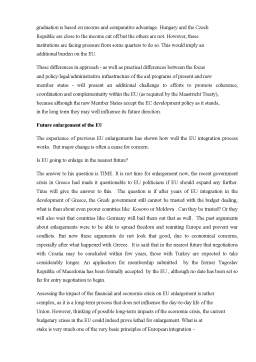Extras din referat
EU is open to any European country that is build on democracy, has a market economy and possesses the administrative capacity to deal with the rights and obligations of membership. To be able to join European Union, a state needs to complete certain economic and political conditions called Copenhagen Criteria (is a list of rules that define if a country is eligible to join European Union), it requires states to have a stable democratic government which respects the rule of law with its corresponding freedoms and institutions. Each current and newly joined member state and the European Parliament must agree to any enlargement, this is according to Maastricht Treaty.
Enlargement is a process of expending thru the accession of new member countries. It is still an ongoing process. The process originally began with the Inner Six (Belgium, France, West Germany, Italy, Luxembourg, Netherlands) which are the six founding member states of European Communities; they founded ECSC (European Coal and Steel Community) in 1952. With welcoming new members , it has also developed a single market and a single currency, and enlarged its responsibilities from economic and social policies to take care of foreign and security policies. Enlargement has been part of the EU agenda since as early as the 1960s. Since the first expansion in 1973, the EU has grown gradually every decade: from the original six founding members to the current ones. The two most recent enlargements of the EU in May 2004 and January 2007 have brought new challenges for communicating various issues in the field of EU development aid.
Being or Becoming a new EU member
The main priorities for EU development aid are:
- Poverty reduction in the developing countries
- Promoting economical growth in the developing countries.
- Building infrastructures in the developing countries.
- Helping developing countries to develop their trade in goods and services.
- Tackling environmental problems in developing countries.
At present the economies of the countries which have become members since 2004 are growing more strongly than those of the others. This is bringing more prosperity to the newcomers, creating new jobs. The gap between living standards across the Union is narrowing, with per capita GDP in countries like Slovenia or Cyprus rising closer to EU average. One of the main tasks for the new members of the EU has been to take responsibilities to secure their frontiers which now became external boundaries of the Union.
The new member states take on EU’s many cooperation partnerships and association agreements as well as EU’s Council Regulation associating the Overseas Countries and territories. Beyond Cooperation agreements with Asia, Latin America, and the Medetiranians, the new member states will take on the rest of EC’s trade acquis and trading policies, including the tariff preferences in favor of the developing countries and especially the Least Developing Countries. In terms of tariffs protection Romania and Poland had to level their levels of tariffs by around 2/3. There are exceptions, like the Baltic Stated own trade policies were very liberal, even more than EC’s.
There is an enormous effort underway in the candidate countries and in the EU to prepare the new members to participate in the EU development assistance. This tends to focus
on formal technical procedures. There are legal and regulatory and financial obligations
that need attention from the development perspective. Procurement regulations are to be
adopted. Enterprises and NGOs from the new member states would be able to participate
in the tendering procedures to participate in the delivering of European Aid to developing
countries. Officials from new members must participate in development-related
Committees. But it is important not to ignore other important aspects of the preparation and
integration process. This includes building the policy and institutional capacity for
development not only to participate in the EU community policy but also at the bilateral
and multilateral level.
Recent Developments
More than half the money spent to help poor countries comes from the European Union and its member states, making it the world's biggest aid donor. But development policy is about more than providing clean water and surfaced roads, important though these are. The Union also uses trade to drive development by opening its markets to exports from poor countries and by encouraging them to trade more with each other.
Preview document
Conținut arhivă zip
- EU Recent Developments.doc






















